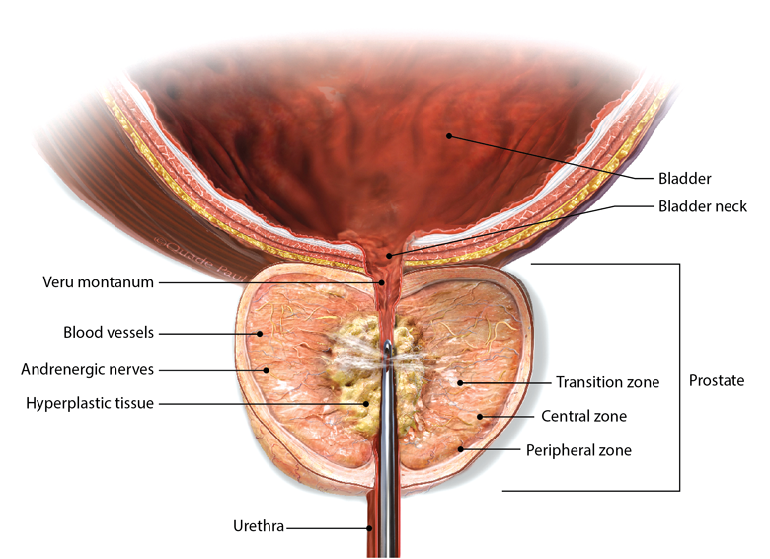Treatments for Benign Prostatic Hyperplasia
In This Article
- Current treatments generally focus on oral medications or invasive surgery, which can have side effects
- The prostatic urethral lift and water steam therapy are new, effective non-invasive treatments for BPH
Benign prostatic hyperplasia (BPH) is one of the most common diseases of aging men. More than 50% of men by age 50, and 80% of men by age 70, develop symptoms related to enlargement of the prostate, which include going to the bathroom more often and slow urinary stream. If left untreated, BPH can affect quality of life and lead to urinary retention, damage to the kidneys and serious urinary tract infections. Patients with untreated BPH also have increased risk of developing heart disease compared to men of the same age without BPH, as well as an increased risk of hip fracture.
Subscribe to the latest updates from Urology Advances in Motion
Two techniques have been developed to bring a subset of these patients an effective treatment without the side effects of invasive surgery: the urethral lift procedure (Figure 1) and thermal vapor therapy (Figure 2). Both are minimally invasive outpatient procedures.

Figure 1: Urethral Lift Procedure, Before and After
Images from inside the urethra of a patient before and after the prostatic urethral lift. On the left, the urethra is compressed by the prostatic hyperplasia. On the right, after the implants have been inserted, the urethra has opened up, thus relieving the symptoms of BPH.
"These two treatments are really perfect for patients who don't have a very large prostate and seek a treatment that doesn’t have long recovery or significant side effects. They are also ideal for patients who respond to medical therapy but do not want to continue medications because of side effects, or for whom the medications aren't working well," says Shahin Tabatabaei, MD, director of the Prostate Health Program at Massachusetts General Hospital.
Typically, medications can treat patients with mild symptoms, and surgery is usually reserved for patients with severe symptoms and cases where the prostate is very large. That makes the urethral lift procedure and thermal vapor therapy appealing to a middle group of patients who may not respond well to medication but aren’t ready for an invasive surgery.
Urethral Lift Procedure and Thermal Vapor Therapy
The prostatic urethral lift is a method to mechanically reshape the prostate by applying tiny implants that help tuck the gland to the side, opening the urethra so that urine flow can be improved. Implants consist of two tiny bars of stainless steel held together with a surgical suture. The bars rest on either side of the prostate, holding it out of the way. The implants can be left in the prostate indefinitely.
The largest prospective, randomized controlled study of the prostatic urethral lift, published in European Urology Supplements, yielded promising results. International Prostate Symptom Score (IPSS) remained improved by 36%, quality of life remained improved by 50%, and urine flow remained improved by 44% from baseline. The retreatment rate was 2% to 3% per year over five years. Symptom relief occurred within nine days, and patients’ sexual function was preserved.
The prostatic urethral lift procedure was approved by the FDA in 2013, and Dr. Tabatabaei and others at Mass General were the first to offer this procedure to patients under local anesthesia. They continue to follow their patients in a registry to evaluate long-term outcomes of the procedure. Mass General clinicians are also working with industry partners to develop a next-generation device to make the procedure even less invasive, and they are refining criteria to evaluate which patients are most likely to benefit from the treatment.
Thermal vapor therapy is a second approach; it uses heat in the form of water vapor to kill cells in the hyperplastic tissue. "The BPH is like a chamber, so the heat from the steam can diffuse and affect the whole chamber in a fast and efficient way," Dr. Tabatabaei says. In a procedure similar to that of the urethral lift, the steam is injected into the prostate through a small needle introduced into the urethra. The vapor therapy treatment was approved by the FDA in 2015.

Figure 2: Thermal Vapor Therapy Treatment
Vapor therapy is delivered through a needle that is inserted into the urethra. The vapor is injected into the hyperplastic tissue.
Selecting Appropriate Treatment for BPH
Choosing one procedure over the other depends on the size and shape of the patient's prostate. "Patients who have an extra lobe of the prostate, the median lobe, will not benefit from the prostatic urethral lift, but they are good candidates for vapor therapy," Dr. Tabatabaei says.
However, vapor therapy requires patients to have a catheter for two to three days, and a small number of patients may need a catheter for several weeks. As a result, according to Dr. Tabatabaei, most patients prefer the prostatic urethral lift unless they have a large median lobe of the prostate. In that case they would choose vapor therapy.
These new procedures aren't meant to replace existing treatments, but rather to complement them. "There are patients whose prostate shape and size isn't appropriate for these treatments," Dr. Tabatabaei says. "They will still need to undergo laser treatment for BPH, but now we have a couple of good solutions for the intermediate group that previously wasn't well served."
About the Prostate Health Program